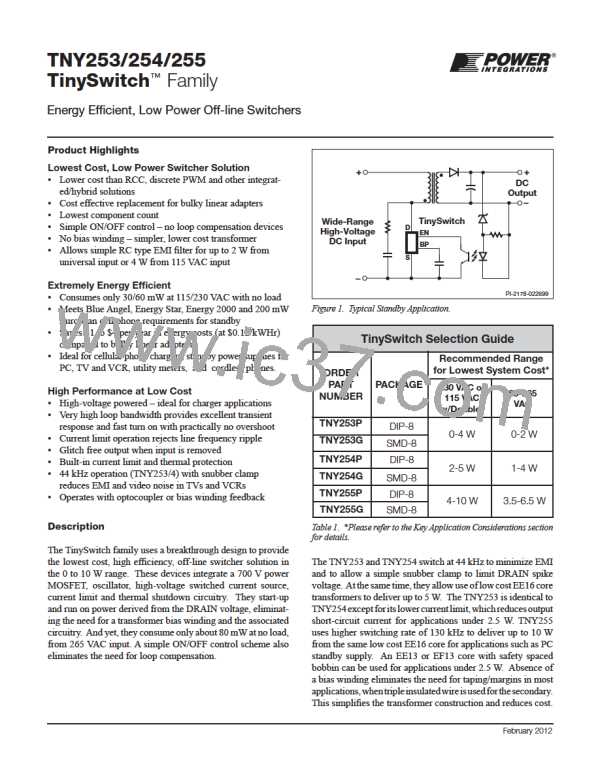Thisꢀprovidesꢀseveralꢀadvantages.ꢀAtꢀhigherꢀswitchingꢀfrequen-
TNY253/254/255
V
V
EN
EN
CLOCK
CLOCK
DC
DC
MAX
MAX
I
I
DRAIN
DRAIN
V
V
DRAIN
DRAIN
PI-2259-061298
PI-2255-061298
Figure 4. TinySwitch Operation at Heavy Load.
Figure 5. TinySwitch Operation at Medium Load.
TheꢀresponseꢀtimeꢀofꢀTinySwitchꢀON/OFFꢀcontrolꢀschemeꢀisꢀ
veryꢀfastꢀcomparedꢀtoꢀnormalꢀPWMꢀcontrol.ꢀꢀThisꢀprovidesꢀhighꢀ
lineꢀrippleꢀrejectionꢀandꢀexcellentꢀtransientꢀresponse.ꢀ
rejectionꢀandꢀrelativelyꢀconstantꢀpowerꢀdeliveryꢀindependentꢀ
ofꢀtheꢀinputꢀvoltage.
44 kHz Switching Frequency (TNY253/254)
Power Up/Down
Switchingꢀfrequencyꢀ(withꢀnoꢀcycleꢀskipping)ꢀisꢀsetꢀatꢀ44ꢀkHz.ꢀ
TinySwitchꢀrequiresꢀonlyꢀaꢀ0.1ꢀµFꢀcapacitorꢀonꢀtheꢀBYPASSꢀ
pin.ꢀꢀBecauseꢀofꢀtheꢀsmallꢀsizeꢀofꢀthisꢀcapacitor,ꢀtheꢀpower-upꢀ
delayꢀisꢀkeptꢀtoꢀanꢀabsoluteꢀminimum,ꢀtypicallyꢀ0.3ꢀmsꢀ(Fig-
ureꢀ7).ꢀꢀDueꢀtoꢀtheꢀfastꢀnatureꢀofꢀtheꢀON/OFFꢀfeedback,ꢀthereꢀisꢀ
noꢀovershootꢀatꢀtheꢀpowerꢀsupplyꢀoutput.ꢀꢀDuringꢀpower-down,ꢀ
theꢀpowerꢀMOSFETꢀwillꢀswitchꢀuntilꢀtheꢀrectifiedꢀlineꢀvoltageꢀ
dropsꢀtoꢀapproximatelyꢀ12ꢀV.ꢀꢀTheꢀpowerꢀMOSFETꢀwillꢀthenꢀ
remainꢀoffꢀwithoutꢀanyꢀglitchesꢀ(Figureꢀ8).
cies,ꢀtheꢀcapacitiveꢀswitchingꢀlossesꢀareꢀaꢀsignificantꢀproportionꢀ
ofꢀtheꢀpowerꢀlossesꢀinꢀaꢀpowerꢀsupply.ꢀꢀAtꢀhigherꢀfrequencies,ꢀ
theꢀpreferredꢀsnubbingꢀschemesꢀareꢀRCDꢀorꢀdiode-Zenerꢀclamps.ꢀ
However,ꢀdueꢀtoꢀtheꢀlowerꢀswitchingꢀfrequencyꢀofꢀTinySwitchꢀ,ꢀ
itꢀisꢀpossibleꢀtoꢀuseꢀaꢀsimpleꢀRCꢀsnubberꢀ(andꢀevenꢀjustꢀaꢀcapaci-
torꢀaloneꢀinꢀ115ꢀVACꢀapplicationsꢀatꢀpowersꢀlevelsꢀbelowꢀ4ꢀW).
Secondly,ꢀaꢀlowꢀswitchingꢀfrequencyꢀalsoꢀreducesꢀEMIꢀfilteringꢀ
requirements.ꢀꢀAtꢀ44ꢀkHz,ꢀtheꢀfirst,ꢀsecondꢀandꢀthirdꢀharmon-
icsꢀareꢀallꢀbelowꢀ150ꢀkHzꢀwhereꢀtheꢀEMIꢀlimitsꢀareꢀnotꢀveryꢀ
restrictive.ꢀꢀForꢀpowerꢀlevelsꢀbelowꢀ4ꢀWꢀitꢀisꢀpossibleꢀtoꢀmeetꢀ
worldwideꢀEMIꢀrequirementsꢀwithꢀonlyꢀresistiveꢀandꢀcapaci-
tiveꢀfilterꢀelementsꢀ(noꢀinductorsꢀorꢀchokes).ꢀꢀThisꢀsignificantlyꢀ
reducesꢀEMIꢀfilterꢀcosts.
Bias Winding Eliminated
TinySwitchꢀdoesꢀnotꢀrequireꢀaꢀbiasꢀwindingꢀtoꢀprovideꢀpowerꢀ
toꢀ theꢀ chip.ꢀ ꢀ Insteadꢀ itꢀ drawsꢀ theꢀ powerꢀ directlyꢀ fromꢀ theꢀ
DRAINꢀpinꢀ(seeꢀFunctionalꢀDescriptionꢀabove).ꢀThisꢀhasꢀtwoꢀ
mainꢀbenefits.ꢀꢀFirstꢀforꢀaꢀnominalꢀapplication,ꢀthisꢀeliminatesꢀ
theꢀcostꢀofꢀanꢀextraꢀbiasꢀwindingꢀandꢀassociatedꢀcomponents.ꢀ
Secondly,ꢀforꢀchargerꢀapplications,ꢀtheꢀcurrent-voltageꢀchar-
acteristicꢀoftenꢀallowsꢀtheꢀoutputꢀvoltageꢀtoꢀfallꢀtoꢀlowꢀvaluesꢀ
whileꢀstillꢀdeliveringꢀpower.ꢀꢀThisꢀtypeꢀofꢀapplicationꢀnormallyꢀ
requiresꢀaꢀforward-biasꢀwindingꢀwhichꢀhasꢀmanyꢀmoreꢀassoci-
atedꢀcomponents,ꢀnoneꢀofꢀwhichꢀareꢀnecessaryꢀwithꢀTinySwitch.
Finally,ꢀifꢀtheꢀapplicationꢀrequiresꢀstringentꢀnoiseꢀemissionsꢀ
(suchꢀasꢀvideoꢀapplications),ꢀthenꢀtheꢀTNY253/254ꢀwillꢀallowꢀ
moreꢀeffectiveꢀuseꢀofꢀdiodeꢀsnubbingꢀ(andꢀotherꢀsecondaryꢀ
snubbingꢀtechniques).ꢀꢀTheꢀlowerꢀswitchingꢀfrequencyꢀallowsꢀ
RCꢀsnubbersꢀtoꢀbeꢀusedꢀtoꢀreduceꢀnoise,ꢀwithoutꢀsignificantlyꢀ
impactingꢀtheꢀefficiencyꢀofꢀtheꢀsupply.
Current Limit Operation
EachꢀswitchingꢀcycleꢀisꢀterminatedꢀwhenꢀtheꢀDRAIN currentꢀ
reachesꢀtheꢀcurrentꢀlimitꢀofꢀtheꢀTinySwitch.ꢀꢀForꢀaꢀgivenꢀprimaryꢀ
inductanceꢀandꢀinputꢀvoltage,ꢀtheꢀdutyꢀcycleꢀisꢀconstant.ꢀꢀHow-
ever,ꢀdutyꢀcycleꢀdoesꢀchangeꢀinverselyꢀwithꢀtheꢀinputꢀvoltageꢀ
providingꢀ“voltageꢀfeed-forward”ꢀadvantages:ꢀgoodꢀlineꢀrippleꢀ
130 kHz Switching Frequency (TNY255)
Theꢀ switchingꢀ frequencyꢀ (withꢀ noꢀ cycleꢀ skipping)ꢀ isꢀ setꢀ atꢀ
130ꢀkHz.ꢀꢀThisꢀallowsꢀtheꢀTNY255ꢀtoꢀdeliverꢀ10ꢀWꢀwhileꢀstillꢀ
usingꢀtheꢀsameꢀsize,ꢀlowꢀcostꢀtransformerꢀ(EE16)ꢀasꢀusedꢀbyꢀ
theꢀTNY253/254ꢀforꢀlowerꢀpowerꢀapplications.
Rev E
02/12
4

 POWERINT [ Power Integrations ]
POWERINT [ Power Integrations ]